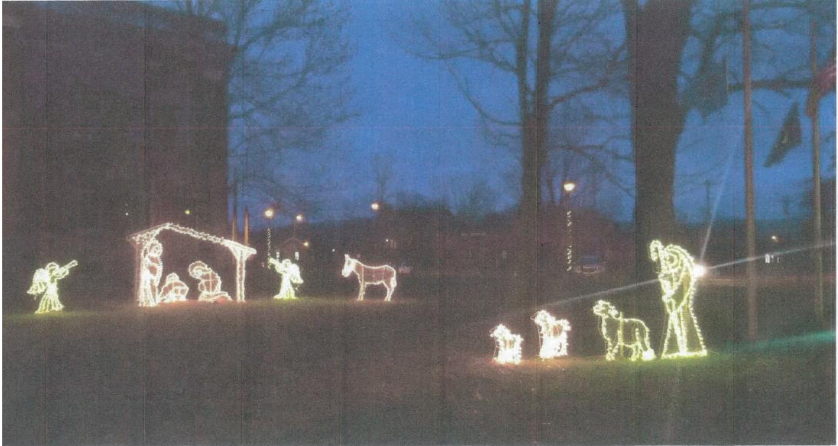
The Freedom From Religion Foundation is severely criticizing an appeals court ruling handed down Feb. 2 that dubiously claims a historical framework justifies a government nativity display.
Although FFRF was not party to the lawsuit, the national state/church watchdog had sent a December 2018 letter demanding removal of the Christian nativity display erected annually on the lawn of the Jackson County Courthouse in Brownstown, Ind. The request was greeted by a “save the nativity” rally with prayers and a speech by the president of the county commissioners. The county moved some figures of Santa Claus and carolers closer to the Christian devotional scene to argue that the overall impact of the display was supposedly secular.
The Indiana ACLU then filed suit on behalf of atheist Rebecca Woodring to challenge the county display of the creche, which is owned by the Brownstown Ministerial Association. U.S. District Court Judge Tanya Walton Pratt ruled in Woodring’s favor last May, writing that the scene continued to convey religious endorsement. The county, represented by the ultra-Christian Right Liberty Counsel, then took the case to the 7th U.S. Circuit Court of Appeals.
Writing the decision for the three-judge panel, which ruled 2-1 in favor of the display, was U.S. Circuit Judge Amy St. Eve, a President Trump appointee: “We conclude that the county’s nativity scene is constitutional because it fits within a long national tradition of using the nativity scene in broader holiday displays to celebrate the origins of Christmas — a public holiday.”
St. Eve claimed that the district court wrongly felt itself bound by the “purpose” and “endorsement” tests based on the Lemon Test, a codification of court rulings that considers a government display constitutional if its purpose is secular and it does not appear to endorse religion. She asserted that the facts of the case must be scrutinized “under the historical approach” from a set of outlier cases dealing with governmental prayer, in which a supposed unbroken practice of congressional chaplaincies creates a justification for governmental prayer.
The appeals court decision invoked the 2019 Supreme Court ruling in AHA v. American Legion that approved a huge cross on public property in Bladensburg, Md. The 7th Circuit asserted that the American Legion decision required the court to not apply the traditional Lemon framework to nativity scene cases. Shockingly joining St. Eve was Judge Diane Wood, a President Clinton appointee considered a counterweight to the circuit’s well-known conservatism. In his vigorous dissent, U.S. Circuit Judge David Hamilton, a President Obama appointee, noted that “the religious content dominates the county’s Christmas display here” and correctly concluded, “Viewed in its entirety and in context, the display therefore sends a strong message of government endorsement of Christianity.”
The decision not only references FFRF in its recitation of the facts, but says: “. . . amicus Freedom From Religion Foundation tells us that we may not disregard binding precedent until it is overturned. But that is not entirely true. … Our prior decisions on passive holiday displays that feature nativity scenes have been ‘undermined’ by American Legion.”
FFRF’s friend-of-the-court brief supporting Woodring had urged: “Ending the annual, seasonal display of the nativity scene in front of the Jackson County Courthouse does not convey hostility to Christianity, but rather embraces neutrality, protecting the diversity of religious beliefs, and the constitutional rights, of all Jackson County residents.”
Hamilton got it right in his dissent: “It’s not as simple as counting whether there are more shepherds and angels than elves and snowmen. . . . the broad principle against government endorsement of particular religions provides a workable standard. If the display is dominated by religious symbolism, with only minor or token secular symbols and symbols of other faiths, the message of endorsement calls for court intervention.”
Comments FFRF Co-President Annie Laurie Gaylor: “The court is arguing that if the constitutional separation between state and church is repeatedly entangled, this ‘history’ of repeated entanglement somehow magically erases the violation. This is an insulting sleight of hand. Winter season after season, a courthouse display endorses Christianity. Such repeated exposure obviously makes the violation cumulatively much worse.”
She called the decision a troubling sign of Trump’s lingering influence on the federal judiciary.
The Freedom From Religion Foundation is a national nonprofit organization with more than 33,000 members across the country, including almost 500 members in Indiana. FFRF’s purposes are to protect the constitutional principle of separation between church and state, and to educate the public on matters relating to nontheism.
